The following high-resolution versions of the figures from the
sauropod neck-posture paper are for the benefit of scientists and
reporters. Feel free to reproduce or modify these for use in
scientific (i.e. peer-reviewed) literature, or in reporting on this
paper in the popular media. Please do not reproduce these
in other non-scientific contexts without explicit permission from
the authors. (We'll probably give permission, but you need to
check.)
Figures 1 and 2 appear in greyscale in the publication, but here we
provide the colour versions. The published versions of these
figures were produced simply by converting the images from RGB to
greyscale in GIMP (a free program similar to PhotoShop).
|
Figure 1.
Cape hare Lepus capensis RAM R2 in right lateral view,
illustrating maximally extended pose and ONP: skull, cervical
vertebrae 1-7 and dorsal vertebrae 1-2. Note the very weak dorsal
deflection of the base of the neck in ONP, contrasting with the much
stronger deflection illustrated in a live rabbit by Vidal et
al. (1986: fig. 4). Scale bar 5 cm.
|
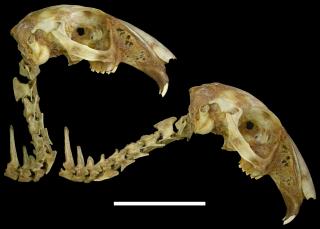
|
|
Figure 2.
Chicken Gallus domesticus RAM R1 in right lateral view,
illustrating maximally extended pose and ONP: last four cervical and
first four dorsal vertebrae. Note the strong ventral deflection of the
base of the neck in ONP, contrasting with the very strong dorsal
deflection illustrated in a live chicken by Vidal et al. (1986:
fig. 7). Scale bar 5 cm.
|
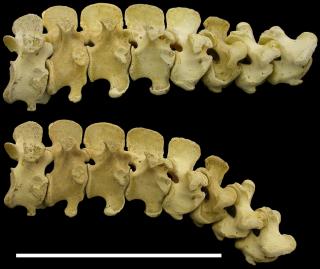
|
|
Figure 3.
Phylogeny indicating high-level relationships between tetrapod groups,
habitual neck posture in extant groups, and inferred posture in
sauropods. Cervical vertebrae shaded dark grey. Lissamphibia:
Ambystoma tigrinum, after Simons et al. (2000: fig. 4);
Mammalia: cat, after Vidal et al. (1986: fig. 3B); Testudines:
Terrapene carolina, after Landberg et al. (2003, fig. 8);
Squamata: Varanus exanthematicus, after Owerkowicz et
al. (1999: fig. 2A); Crocodylia: alligator, after unpublished
photograph; Aves: chicken, after Vidal et al. (1986: fig. 7);
Sauropoda: Diplodocus carnegii, modelled after vertebrae in
Hatcher (1901: fig. 4, pl. III).
|
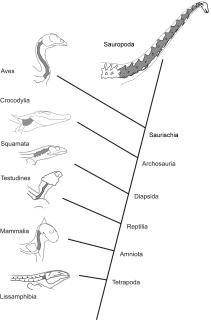
|
|
Figure 4.
Range of possible habitual head angles in the basal sauropodomorph
A. Massospondylus, and the sauropods
B. Camarasaurus and C. Diplodocus. Heads
shown with HSSC oriented horizontally, and tilted 30º upwards and 20º
downwards, the range of habitual orientations found for birds by Duijm
(1951) . Necks shown in neutral position with respect to heads with
horizontal HSCCs. Massospondylus BP/1/4376 after Sues et al. (2004:
fig. 1A), Camarasaurus CM 11338 after Gilmore (1925: pl. XVI),
Diplodocus USNM 2672 after Hatcher (1901: pl. II).
|
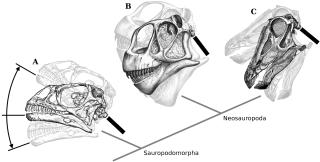
|
|
Figure 5.
Brachiosaurus brancai reconstructions with low and high torso
positions. Neck in ONP, in a drinking posture, and in a browsing
posture attained by deflecting the neck dorsally by the same amount as
it is deflected ventrally to reach the ground. Torso, appendicular
skeleton and ONP neck from Stevens and Parrish (2005b:
fig. 6.8). Cervical joints deflected by 8º from ONP. See text for full
details.
|
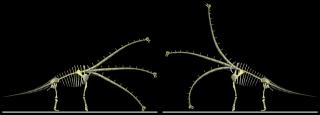
|




